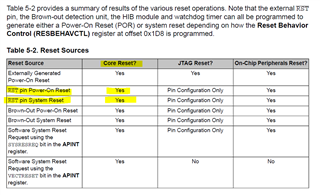Tool/software:
Hi,
I am considering accessing it from the debug port of the TM4C1230H6PM.
-Is the register configuration of the debug port of the TM4C1230H6PM the standard configuration for the ARM Cortex-M4F core? Or is it a custom configuration?
-I don't want the CPU to run when I turn on the power. Is it possible to put the CPU into a halted state by setting the C_HALT bit of the Debug Halting Control and Status Register to 1 while keeping the TM4C1230H6PM pin 38: /RST pin = LOW?
-And in this state, if I change the TM4C1230H6PM pin 38: /RST pin from LOW to HIGH, will the CPU halted state be maintained?
-After that, will it be possible to access the Flash Memory Registers from the debug port?
Regards,
Toru


